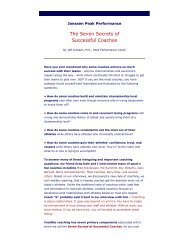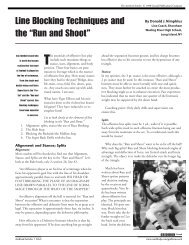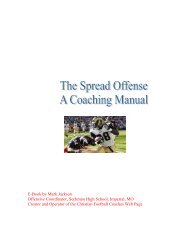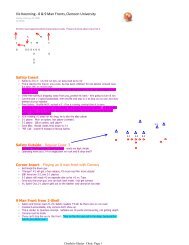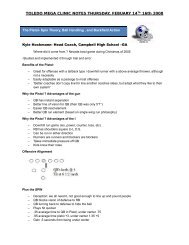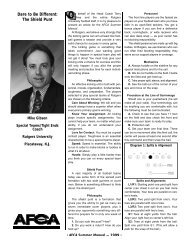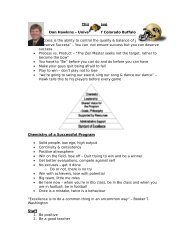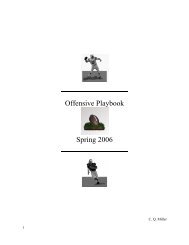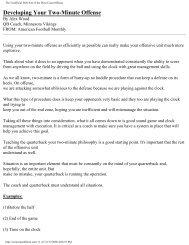Untitled - Fast and Furious Football
Untitled - Fast and Furious Football
Untitled - Fast and Furious Football
You also want an ePaper? Increase the reach of your titles
YUMPU automatically turns print PDFs into web optimized ePapers that Google loves.
TEAMDEFENSE 101<br />
- TIGURE 8 53 Twist{over-1l3-sirong |etr<br />
tr<br />
ft\./a<br />
NE<br />
oo<br />
::e next four-man presBure we uBe out of our<br />
'i.: package is to plug one of our ILBS. If we<br />
- .:.e ro plugwill,we'll simpty call out his name,<br />
: ;3 Will"cover 1/3, shown in Fisue 9. The<br />
-<br />
FIOUBE 9<br />
rC<br />
CCCF<br />
BEN<br />
53 will-coveFl/3-si.ong left<br />
OLB to Will's side replaces him on his pass drop<br />
(unless sprint-out pass).<br />
We put a premirm on keeping it simple <strong>and</strong><br />
having all of our terrninology <strong>and</strong> packages tied<br />
togeth€r. But also realize that .r/lo, you play is<br />
not as important as lro.u you play it. That's what<br />
makes the difference between winning or losing.<br />
: ..) Pr@eed.inss. Coach Slocun is head c@ch at Tetus A&M Uniue.sitr. C@ch DaDie is defensiLJe c@rd.inator at<br />
' ,tLercit\ of Notre Dame.<br />
,A B$$l]3{ti1 ii:1 }*{il il ii!r-t|l$}liil!i<br />
The Eagle Defense<br />
BILLDOOLEY<br />
: $ e cr i gr $ r l1 $ * Q ilt t ii $ ]t6 u !1ii, ic i t<br />
i - :e a 50 shade defense, but there are some<br />
---:le differences in bow we play the 50 shade<br />
: r:iage as compared to most progmms. Fi$t, we<br />
, . trls play our strcng safety on the Eagle side.<br />
>:rnd, we align the Eagle look where we want<br />
.\'e feel that with these two concepts integrated<br />
- :: ou. sc}lem€, we can better deploy our per-<br />
. :1e1 <strong>and</strong> achieve the defemive look we want<br />
=Jnst oul opponenh. With these conceptE <strong>and</strong><br />
.. .re very good athletes, our defeme has been<br />
:.:e to accomplish its objectives. Our defemive<br />
,. .ct;ves atcn't much al;fferent frofi most prc-<br />
-.-::.. Those objectiveB are:<br />
. Conhol the opponent's running game.<br />
. Force the opponent into pass situations.<br />
. Prevent the long run or pass.<br />
. Score or set up a score.<br />
. Keep the opponent from scodng.<br />
$'e emphasize the first objective-to contml<br />
::. opponents rundng game. If we control the<br />
-:.nlng attack, w€ can force the oppon€nt into<br />
long-yardage pass situations. ThiB is ahigh-risk,<br />
low-percentage situation for the olfense the t]e<br />
of situation wh€re the defense is in control.<br />
We believ€ in the "gap contrcl theory" of defense.<br />
We warlt each man in our defensive ftont<br />
to be responsible for €onholling one gap. Each<br />
gap <strong>and</strong> the corresponding techniques that our<br />
front people play are numbered according to the<br />
numbering system made lamous at Alabama by<br />
Coach Bear Bryant (s€e Fieure 1).<br />
FIGUBE I<br />
Gap nu'',be ng systen<br />
ooorooo<br />
967 54 321 O 123 45 769<br />
We want simplicity <strong>and</strong> repetition in everything<br />
we do. If we're goine to ask our ftont people<br />
to contuol a gap, then we want to teach them the<br />
simplest <strong>and</strong> most effective way to control that<br />
gap. We do this bJ asking our fiont people to piay



